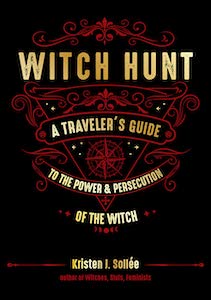
Witch Hunt: A Traveler’s Guide to the Power and Persecution of the Witch, by Kristen J. Sollee
Weiser Books, 1578636990, 256 pages, October 2020
Kristen Sollee has written several books on the legacy of the witch, a subject that is hugely interesting to me. Yet I have to say, the thing that excited me most about Witch Hunt: A Traveler’s Guide to the Power and Persecution of the Witch is that not only was it a book about witches and history, but it was also about travel. After this past year of pandemic lockdown, a virtual tour of the world and of witchcraft was just the thing I needed to bring a little adventure and magic to my cabin feverish soul.
Sollee records her travels throughout Europe and North America as she visits significant sites connected to witches, witch hunts, and the persecution of witches. Somehow, she manages to write about episodes in this history that are terrifying, violent – and at times harrowing to the degree of being unimaginable – with grace, thoughtfulness, and insight, as well as second sight.
The author deftly weaves her own imaginings of witchy characters, their voices, thoughts, actions, and motivations into her telling of historical periods, beginning with Giovanna, a sultry fifteenth century sex witch proficient in glamour magic that takes a seat next to the author on a park bench in Florence, Italy.
As we move through Italian cities and witchscapes, we arrive at Vatican City in a chapter chock full of the most delightful descriptions of surprisingly witchy art pieces and artifacts, including a fresco of the Greek goddess of love, Aphrodite, a statue of the Egyptian lioness goddess of war, Sekhmet, and a ceramic kylix depicting the Greek goddess of wisdom, Athena. Also spotted: “…another beautiful Roman mosaic from the third century AD where Medusa makes an appearance with her glorious snaky mane unfurled.”1 I have never desired to visit Vatican City until now.
We continue our trek moving through France, meeting Joan of Arc in a wonderful telling of not only how she affected her current time, but also how The Maid’s legacy is still influencing diverse groups of people today, being not only the most famous “witch” figure to have ever lived, but the most famous saint as well.
Our visit to Paris is bedecked with not only the history of The Affair of the Poisons but descriptions of alleged Satanic rituals that were reported in confessionals and resulted in executions. The confessed sins, as well as the execution methods, are truly horrifying (and for me fell into the unimaginable category).
Sollee’s journey then takes us up onto German mountaintops (where witches were accused of arriving via flying broomstick), where we visit a witch themed amusement park complete with museums filled with torture devices, before traveling on to Ireland, England, and Scotland.
In the last five chapters we meet the witches of America with visits to Virginia, Delaware, Connecticut, Massachusetts, and New York.
Sollee does a wonderful job connecting history with the present, and this was probably my favorite aspect of the book. Her way of presenting how past events influence us today and her vivid characterizations of place, which not only include visual descriptions but energetic ones as well, I found captivating.
The author recounts that as she was settling into bed while in Virginia, she turned on the TV to see the 700 Club with Protestant preacher Pat Robertson. She watched until she could stomach no more; she turned the TV off and found herself pondering how much and how little the American religious landscape has changed since the days of King James. I found myself having similar thoughts through the entire reading of this book. How much and how little, indeed.
I also found myself ready to hop on a plane, and much of the time the desire I had was to revisit places in Europe that I have already been, but was previously never aware of these specific places or history. For me, reading this book was like seeing all these places anew. My travel wish list has now doubled in size.
The book concludes with nearly two dozen pages of travel resources and a lengthy bibliography for those inclined to book a witch trip or do further research.
I enjoyed Witch Hunt and highly recommend it to anyone who is interested in witch lore, witch history, and travel. It fits the bill and ties all three of these interests together into one enchanting tome.

Cindie Chavez, “The Love & Magic Coach”, is a certified life and relationship coach as well as an author, speaker, and teacher. She has a reputation for bringing astounding clarity and having a wicked sense of intuition. She has a widely diverse range of other proficiencies and interests including astrology, kabbalah, tarot, magic, and spirituality. She also loves painting, knitting, gaming, and enjoying belly laughs with her husband and family.
